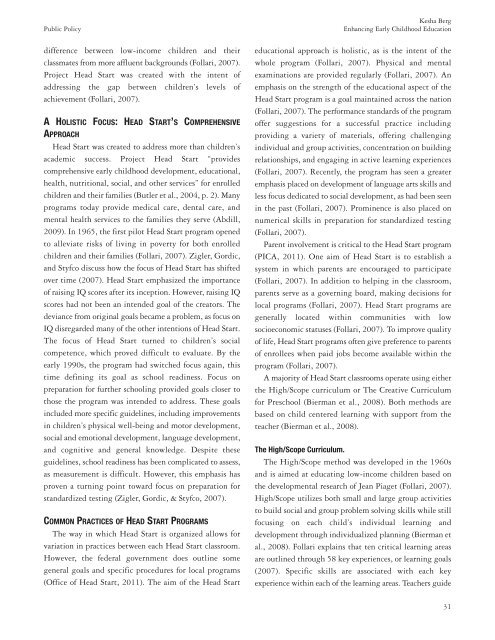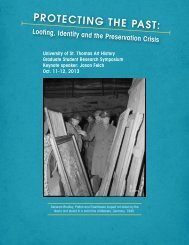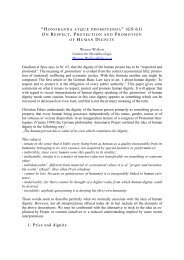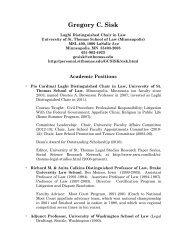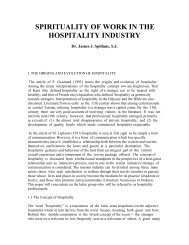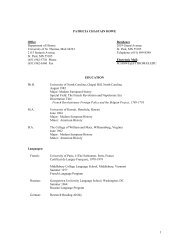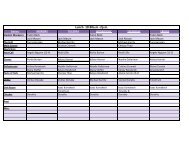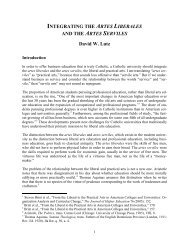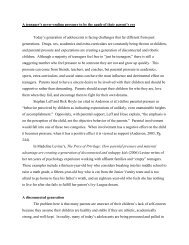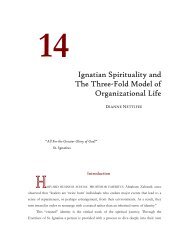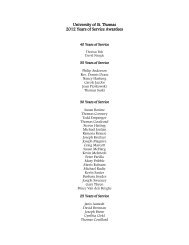dr. ronald e. mcnair acknowledgements - University of St. Thomas
dr. ronald e. mcnair acknowledgements - University of St. Thomas
dr. ronald e. mcnair acknowledgements - University of St. Thomas
You also want an ePaper? Increase the reach of your titles
YUMPU automatically turns print PDFs into web optimized ePapers that Google loves.
Kesha Berg<br />
Public Policy Enhancing Early Childhood Education<br />
difference between low-income chil<strong>dr</strong>en and their<br />
classmates from more affluent backgrounds (Follari, 2007).<br />
Project Head <strong>St</strong>art was created with the intent <strong>of</strong><br />
ad<strong>dr</strong>essing the gap between chil<strong>dr</strong>en’s levels <strong>of</strong><br />
achievement (Follari, 2007).<br />
A HOLISTIC FOCUS: HEAD START’S COMPREHENSIVE<br />
APPROACH<br />
Head <strong>St</strong>art was created to ad<strong>dr</strong>ess more than chil<strong>dr</strong>en’s<br />
academic success. Project Head <strong>St</strong>art “provides<br />
comprehensive early childhood development, educational,<br />
health, nutritional, social, and other services” for enrolled<br />
chil<strong>dr</strong>en and their families (Butler et al., 2004, p. 2). Many<br />
programs today provide medical care, dental care, and<br />
mental health services to the families they serve (Abdill,<br />
2009). In 1965, the first pilot Head <strong>St</strong>art program opened<br />
to alleviate risks <strong>of</strong> living in poverty for both enrolled<br />
chil<strong>dr</strong>en and their families (Follari, 2007). Zigler, Gordic,<br />
and <strong>St</strong>yfco discuss how the focus <strong>of</strong> Head <strong>St</strong>art has shifted<br />
over time (2007). Head <strong>St</strong>art emphasized the importance<br />
<strong>of</strong> raising IQ scores after its inception. However, raising IQ<br />
scores had not been an intended goal <strong>of</strong> the creators. The<br />
deviance from original goals became a problem, as focus on<br />
IQ disregarded many <strong>of</strong> the other intentions <strong>of</strong> Head <strong>St</strong>art.<br />
The focus <strong>of</strong> Head <strong>St</strong>art turned to chil<strong>dr</strong>en’s social<br />
competence, which proved difficult to evaluate. By the<br />
early 1990s, the program had switched focus again, this<br />
time defining its goal as school readiness. Focus on<br />
preparation for further schooling provided goals closer to<br />
those the program was intended to ad<strong>dr</strong>ess. These goals<br />
included more specific guidelines, including improvements<br />
in chil<strong>dr</strong>en’s physical well-being and motor development,<br />
social and emotional development, language development,<br />
and cognitive and general knowledge. Despite these<br />
guidelines, school readiness has been complicated to assess,<br />
as measurement is difficult. However, this emphasis has<br />
proven a turning point toward focus on preparation for<br />
standardized testing (Zigler, Gordic, & <strong>St</strong>yfco, 2007).<br />
COMMON PRACTICES OF HEAD START PROGRAMS<br />
The way in which Head <strong>St</strong>art is organized allows for<br />
variation in practices between each Head <strong>St</strong>art classroom.<br />
However, the federal government does outline some<br />
general goals and specific procedures for local programs<br />
(Office <strong>of</strong> Head <strong>St</strong>art, 2011). The aim <strong>of</strong> the Head <strong>St</strong>art<br />
educational approach is holistic, as is the intent <strong>of</strong> the<br />
whole program (Follari, 2007). Physical and mental<br />
examinations are provided regularly (Follari, 2007). An<br />
emphasis on the strength <strong>of</strong> the educational aspect <strong>of</strong> the<br />
Head <strong>St</strong>art program is a goal maintained across the nation<br />
(Follari, 2007). The performance standards <strong>of</strong> the program<br />
<strong>of</strong>fer suggestions for a successful practice including<br />
providing a variety <strong>of</strong> materials, <strong>of</strong>fering challenging<br />
individual and group activities, concentration on building<br />
relationships, and engaging in active learning experiences<br />
(Follari, 2007). Recently, the program has seen a greater<br />
emphasis placed on development <strong>of</strong> language arts skills and<br />
less focus dedicated to social development, as had been seen<br />
in the past (Follari, 2007). Prominence is also placed on<br />
numerical skills in preparation for standardized testing<br />
(Follari, 2007).<br />
Parent involvement is critical to the Head <strong>St</strong>art program<br />
(PICA, 2011). One aim <strong>of</strong> Head <strong>St</strong>art is to establish a<br />
system in which parents are encouraged to participate<br />
(Follari, 2007). In addition to helping in the classroom,<br />
parents serve as a governing board, making decisions for<br />
local programs (Follari, 2007). Head <strong>St</strong>art programs are<br />
generally located within communities with low<br />
socioeconomic statuses (Follari, 2007). To improve quality<br />
<strong>of</strong> life, Head <strong>St</strong>art programs <strong>of</strong>ten give preference to parents<br />
<strong>of</strong> enrollees when paid jobs become available within the<br />
program (Follari, 2007).<br />
A majority <strong>of</strong> Head <strong>St</strong>art classrooms operate using either<br />
the High/Scope curriculum or The Creative Curriculum<br />
for Preschool (Bierman et al., 2008). Both methods are<br />
based on child centered learning with support from the<br />
teacher (Bierman et al., 2008).<br />
The High/Scope Curriculum.<br />
The High/Scope method was developed in the 1960s<br />
and is aimed at educating low-income chil<strong>dr</strong>en based on<br />
the developmental research <strong>of</strong> Jean Piaget (Follari, 2007).<br />
High/Scope utilizes both small and large group activities<br />
to build social and group problem solving skills while still<br />
focusing on each child’s individual learning and<br />
development through individualized planning (Bierman et<br />
al., 2008). Follari explains that ten critical learning areas<br />
are outlined through 58 key experiences, or learning goals<br />
(2007). Specific skills are associated with each key<br />
experience within each <strong>of</strong> the learning areas. Teachers guide<br />
31


